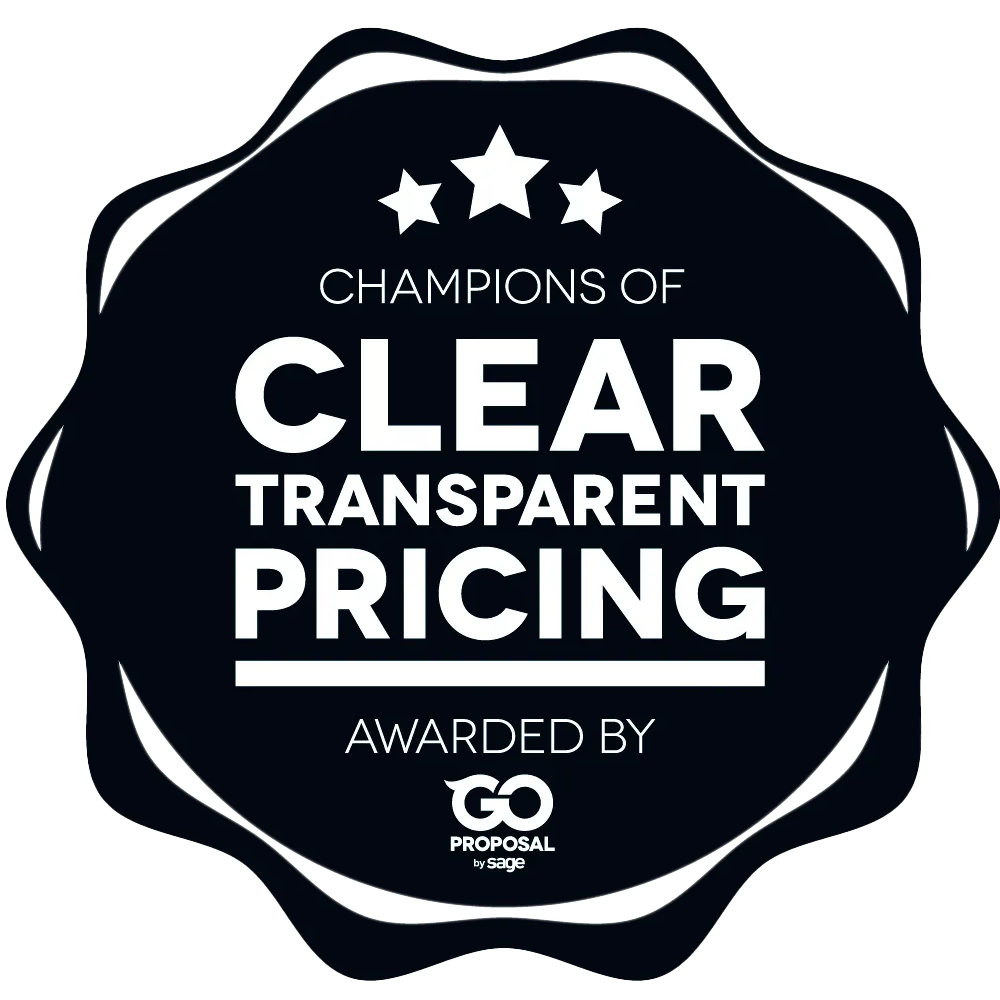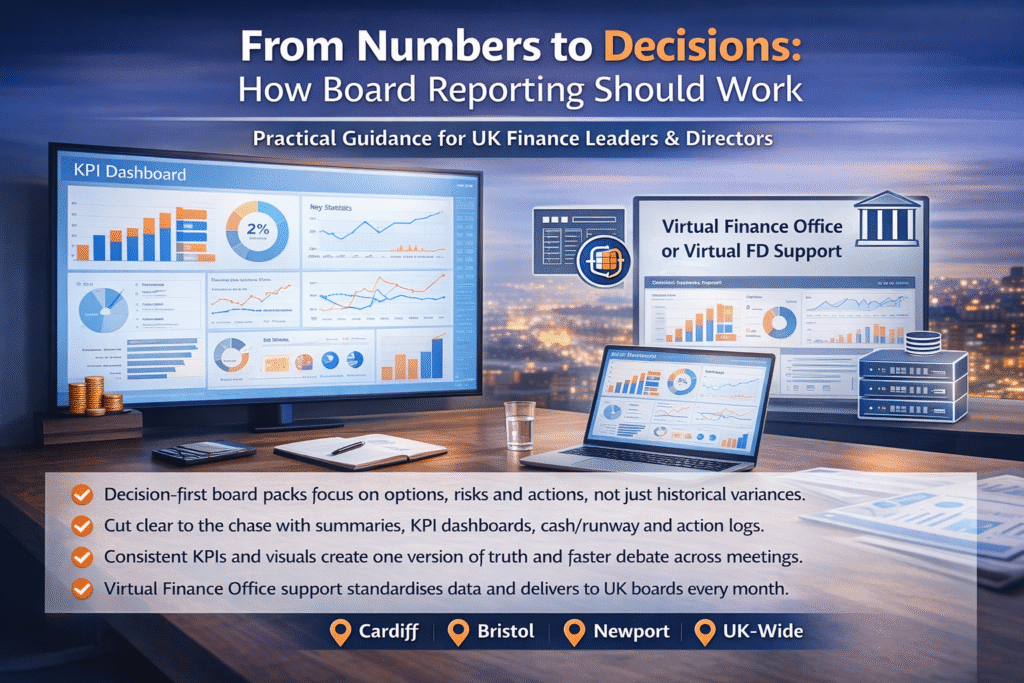If you’re hitting profit targets yet still sweating payroll, suppliers, or the VAT quarter, the problem isn’t your margins—it’s your timing and controls. Cash leaves earlier than it arrives, small leaks add up, and no one is truly owning the working-capital levers week by week. The fix isn’t a bigger spreadsheet; it’s a cadence led by a Virtual Finance Director (VFD)—also called a fractional CFO or part-time CFO—who turns profit on paper into cash in the bank.
This article explains why profit ≠ cash, where money gets stuck (your cash conversion cycle), how hidden drains bleed your balance, and how a light-touch 13-week cash plan under VFD stewardship restores discipline and visibility—without slowing growth.
Key takeaways
- Profit and cash move on different calendars. Accrual accounting books revenue before money lands; prepayments and tax spikes pull cash forward. Without controls, timing gaps swamp the bank even when the P&L is healthy.
- Your cash conversion cycle (CCC) hides the blockage. If DSO (customers pay late) rises, DIO (stock on shelves) creeps up, and DPO (you pay suppliers too fast) stays low, cash gets trapped.
- Small leaks drain big balances. Unused SaaS, duplicate tools, auto-renewals, refunds, chargebacks, warranty costs, and petty spend quietly erode liquidity each week.
- Growth eats cash before it feeds profit. More stock, more payroll, and looser credit to win new customers stretch working capital, even with strong margins.
- Visibility beats optimism. A rolling view of receipts vs disbursements, variance checks, and clear ownership of AR/AP/inventory stops surprises.
- A VFD installs the cadence. Weekly cash huddles, action logs, spend controls, and a 13-week cash plan put you back in control. The process is light, fast, and focused on decisions—not admin.
Common Questions
Why can a profitable company run out of cash?
Because revenue recognition isn’t the same as money received. Customers pay later (high DSO), stock sits longer (high DIO), and you pay suppliers sooner (low DPO). Add prepayments and tax spikes, and cash drains faster than it refills—even with solid margins.
What is the cash conversion cycle and why does it matter?
The CCC measures how long cash is tied up in operations: CCC = DIO + DSO − DPO. Shorter is better. Reduce days in inventory, collect faster, and avoid paying suppliers earlier than needed to free working capital.
Can growth cause cash problems even if margins are healthy?
Yes. Growth requires stock, people, and credit before revenue lands. That stretches working capital and can cause a liquidity gap even as profits rise.
What hidden drains on cash do owners miss?
SaaS creep, duplicate tools, auto-renewals, refunds, chargebacks, warranty and RMA freight, under-approved travel and subsistence, and “small” capex not in the plan. Each looks minor; together they dent runway.
How does a 13-week cash plan help?
It gives a weekly, rolling view of receipts and disbursements with owners, targets, and actions. Led by a Virtual Finance Director / fractional CFO, it shortens CCC, protects runway, and gives lenders/suppliers confidence.

How can you be profitable on paper but broke in the bank?
Profit counts invoiced sales and accrued costs; cash cares about paid sales and cleared costs. If customers take 45–60 days to pay but suppliers expect 30, you can be profitable and still hit the overdraft. If rent, insurance, or annual SaaS renewals prepay months in advance, your P&L looks calm while your bank balance drops. The fix is simple to say and hard to do without leadership: line-by-line timing control and a weekly rhythm that prevents drift.
Book a free 15-minute VFD cash consult to map your gaps and set a fast starting plan.
How do accrual accounting and timing differences hide cash issues?
Accruals smooth performance; cash timing makes or breaks payroll.
- Revenue vs receipts: You book revenue when you deliver, not when you get paid. Long credit terms or slow collections push cash out of step with profit.
- Prepayments and deposits: Rent, insurance, licences, and supplier deposits front-load cash outflows well before the P&L recognises the cost.
- Deferred revenue and WIP: In services, work in progress and milestone billing create billing gaps that hold cash back.
- Taxes: VAT, PAYE/NIC, and Corporation Tax land in lumpy spikes. The P&L accrues; the bank takes the hit on the due date.
What is the cash conversion cycle—and where is your cash stuck today?
Your cash conversion cycle (CCC) shows the number of days cash is tied up in operations:
CCC = DIO (Days Inventory Outstanding) + DSO (Days Sales Outstanding) − DPO (Days Payable Outstanding)
- If DSO rises: customers are paying slower; cash is stuck in receivables.
- If DIO rises: stock sits longer; cash is stuck on the shelf.
- If DPO falls: you’re paying suppliers faster than necessary; cash leaves early.
Map your order-to-cash and procure-to-pay flows. Ask: Where do we wait? Who owns each wait? What policy or tool moves that wait?
Have a look at your cash collection playbook to make your cash conversion cycle shorter.
Which timing gaps are starving your cash despite healthy margins?
Timing gaps are operational, not theoretical:
- Slow collections: weak dunning, disputed invoices, vague credit control.
- Front-loaded costs: deposits, onboarding fees, freight, and duty paid long before revenue lands.
- Billing cadence gaps: “month-end only” invoicing, late milestone bills, annual renewals sent last minute.
- Supplier prepayments: MOQs and pre-buys for discounts that tie up cash.
- Shipping/fulfilment lags: goods in limbo while cash is out and revenue not yet recognised.
How do growth spurts make cash tighter, not looser?
Growth consumes cash first:
- Inventory: more units bought earlier to meet demand; DIO creeps up.
- Payroll: hires onboard before revenue catches up; overtime and contractor costs spike.
- Customer credit: looser terms to win larger accounts; DSO stretches.
- Operations: onboarding costs, training, and systems scale ahead of income.
Healthy gross margins won’t save cash if working capital is starved. Growth needs a runway and a plan for headroom against covenants.
Learn more about how to protect yourself from a cash runway.
What hidden drains quietly erode cash every week?
It’s death by a thousand cuts:
- SaaS creep & duplicate tools: small subs that auto-renew and overlap.
- Unplanned capex & kit: “minor” IT or equipment buys without approval.
- Refunds, chargebacks, warranty: cash leaves faster than recoveries arrive.
- Expense leakage: travel, fuel, subsistence, and petty cash without clear policy.
- Freight & returns: RMA shipping costs and restocking nibble margins and cash.
Create a spend control policy, cleanse the supplier list, and require POs for non-routine spend. Most firms find 2–4% of revenue in leaks within a quarter.
Why do lenders, suppliers and tax authorities drain cash unexpectedly?
- Debt service: amortisation and interest step-ups bite; missed visibility hits covenant headroom.
- Supplier terms: tighter credit when volumes drop or disputes rise; prepayment for new orders.
- HMRC: arrears from a tough quarter; Time-to-Pay ending; penalties and interest compounding.
A week’s warning is not enough. You need forward views and a VFD who keeps lenders, suppliers, and HMRC onside with steady, factual updates.

How does poor cash visibility make things worse?
Operating blind creates self-inflicted shocks:
- No rolling forecast: relying on historic P&L, not receipts/disbursements.
- No variance analysis: collections miss targets and no one adjusts assumptions.
- No ownership: AR/AP/inventory aren’t tied to named owners with weekly deliverables.
- No governance: payment runs drift; approvals happen in email; policies live in heads.
How does a Virtual Finance Director restore discipline and foresight?
A VFD (fractional/part-time CFO) installs a cash cadence that business owners can run with minimal friction:
- Ownership: a RACI so AR, AP, inventory, sales ops and tax each have a named owner and a weekly commitment.
- Policy: a lean credit control playbook, collections cadence, PO & spend approvals, and a standard payment-run rhythm.
- Cadence: a 30-minute weekly cash huddle with a live action log, SLA dates, and escalation thresholds.
- Visibility: a rolling 13-week cash view that shows runway, headroom, and covenant early-warning signals.
- Communication: crisp board/lender updates that build trust and keep facilities flexible.
Please have a look at our board reporting format and make business decisions effectively.
What does a 13-week cash plan actually look like?
We cover the full playbook on our separate guide. Here, a quick snapshot so you see the shape—not the detail:
- Week 1: baseline the model, opening cash, minimum-cash line, owner assignments.
- Weeks 2–4: first variance reviews; collections sprint; supplier prioritisation; payment-run policy live.
- Weeks 5–8: VAT/PAYE calendar stress-test; headroom checks; supplier renegotiations; early wins logged.
Learn more about the 13-week cash flow plan managed by our fractional finance director.
How do you prove where cash leaks—without a 6-month project?
You don’t need a transformation programme. You need 90 minutes and a focused data pull:
- AR/AP ageing, inventory report, bank movements, sales ledger, contract terms, payroll & VAT calendars.
- Build a simple cash ladder (opening → receipts → disbursements → closing).
- Plot runway weeks, variance to forecast, and covenant headroom.
- Highlight the top five blockers; assign owners; set weekly targets.
What results should you expect from week four onward?
- Forecast accuracy ↑: fewer surprises; decisions improve.
- DSO ↓: cash lands sooner; borrowing falls.
- Weeks of runway ↑: stress dips; payroll secure.
- Headroom restored: less covenant anxiety; more negotiating power.
- Fewer emergencies: fewer Friday fire-drills; calmer suppliers.
Optional examples (anonymised):
- £1.2m services firm: DSO down 9 days in six weeks; runway up 3 weeks.
- £3m e-commerce: aged stock clearance released £85k; SaaS clean-up saved £2.5k/month.
- £5m wholesaler: supplier terms extended from 30 to 45 days with a data-backed plan.
When should you act before profit turns into a cash crisis?
- Payroll feels tight more than once a quarter.
- VAT quarter looms and the bank balance won’t stretch.
- Supplier pressure rises and terms shorten.
- Growth spikes but cash is erratic.
Lender questions increase about headroom and covenants.

Book a Free 15 15-minute call with our Financial expert who will suggest how to improve your cash flow quickly and efficiently.
FAQs
Why can a profitable business run out of cash?
Because timing beats margin in the short term. Late receipts (high DSO), slow-moving stock (high DIO), and fast supplier payments (low DPO) lengthen the cash conversion cycle and drain liquidity despite profit.
What is a good cash conversion cycle for my industry?
“Good” depends on your sector and model. The direction matters more than the benchmark. Aim to shorten CCC each quarter by shaving days from DSO and DIO while maintaining sensible DPO.
How quickly can DSO improve with a collections cadence?
With owner-level targets, weekly dunning, and dispute resolution, a 5–10 day DSO improvement over 4–8 weeks is common in SMEs. Faster if billing accuracy improves and credit terms tighten for slow payers.
Will a 13-week cash plan work if revenue is volatile?
Yes. The plan is built for volatility: weekly buckets, rolling horizon, variance analysis, and scenarios (sales dip, debtor default, VAT delay). It’s about visibility and response, not false precision.
How does a VFD hold sales and operations accountable without slowing growth?
By separating ownership from bureaucracy: short cash huddles, clear SLAs, simple action logs, and policy thresholds. Sales focuses on invoice accuracy and promised dates; ops focuses on stock levels and inbound schedules. The VFD orchestrates; the team executes.
Can this integrate with Xero/QuickBooks and bank feeds?
Yes. Pull AR/AP, bank, and payroll automatically; add manual timing adjustments for real-world behaviour. Automation speeds updates; governance protects quality.






